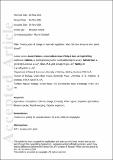Files in this item
Twenty years of change in riverside vegetation : what role have invasive alien plants played?
Item metadata
| dc.contributor.author | Pattison, Zarah | |
| dc.contributor.author | Minderman, Jeroen | |
| dc.contributor.author | Boon, Philip J. | |
| dc.contributor.author | Willby, Nigel | |
| dc.date.accessioned | 2018-01-22T00:31:39Z | |
| dc.date.available | 2018-01-22T00:31:39Z | |
| dc.date.issued | 2017-07 | |
| dc.identifier | 248681669 | |
| dc.identifier | 233724bc-7e3a-4645-a698-ccc77cee0729 | |
| dc.identifier | 85010191176 | |
| dc.identifier | 000403676000011 | |
| dc.identifier.citation | Pattison , Z , Minderman , J , Boon , P J & Willby , N 2017 , ' Twenty years of change in riverside vegetation : what role have invasive alien plants played? ' , Applied Vegetation Science , vol. 20 , no. 3 , pp. 422-434 . https://doi.org/10.1111/avsc.12297 | en |
| dc.identifier.issn | 1654-109X | |
| dc.identifier.other | Bibtex: urn:c56fa417cb30c8a8fe2c5196bd7a27df | |
| dc.identifier.uri | https://hdl.handle.net/10023/12547 | |
| dc.description | We gratefully acknowledge financial support from Scottish Natural Heritage and the Scottish Environmental Protection Agency. | en |
| dc.description.abstract | Question . Which environmental factors influence the occurrence of invasive alien plants (IAPs) in riparian habitats and how much can IAPs account for change in native vegetation compared with other environmental variables? Location . Rivers distributed throughout mainland Britain. Methods . We quantified change in river bank vegetation using survey data collected approximately 20 years apart and assessed the contribution of major IAPs (Impatiens glandulifera, Heracleum mantegazzianum and Fallopia japonica) to these changes, and determined the importance of abiotic factors such as flow regime and land use in driving these changes. Results . Comparing data from pre- and post-1990 surveys revealed that IAPs occurred mainly on lowland rivers (altitude <200m), regardless of time period, and their probability of occurrence increased over time and with rising frequency of high flows. Native plant species diversity declined over time with increasing IAP cover, along lowland rivers, and along all rivers experiencing extended low flows during the growing season. These conditions particularly favoured native dominant species, whereas native subordinate species responded both positively and negatively to increased flood frequency depending on survey period. Over time, native subordinate Salix spp. and larger hydrophilic species, such as native dominant Sparganium erectum, increased along lowland rivers, replacing smaller-statured ruderal species, and driving a shift towards increased shade tolerance of sub-canopy and groundcover species. Smaller compositional changes occurred in the uplands and these changes lacked a clear environmental signature. Conclusions . National scale changes in native riparian vegetation are likely driven primarily by environmental changes and land-use effects, rather than invasion by IAPs. However, IAPs, and indeed native species that benefit from abiotic changes, in turn, likely exert secondary effects on native riparian vegetation. The trend towards reduced diversity, increased shade tolerance and increased dominance of some native species and IAPs is likely linked to a set of interacting factors including drier summers, wetter winters, increased riparian tree cover, reduced livestock access to river banks and increased fine sediment input. Determining combined effects of land use, IAPs and climate-related changes in flow regime over decadal time scales (i.e., ~30 years) is important for predicting ecological responses of vulnerable habitats under future disturbance scenarios. | |
| dc.format.extent | 13 | |
| dc.format.extent | 1185412 | |
| dc.language.iso | eng | |
| dc.relation.ispartof | Applied Vegetation Science | en |
| dc.subject | Agriculture | en |
| dc.subject | Competition | en |
| dc.subject | Climate change | en |
| dc.subject | Diversity | en |
| dc.subject | Flow regime | en |
| dc.subject | Impatiens glandulifera | en |
| dc.subject | Invasive species | en |
| dc.subject | Model averaging | en |
| dc.subject | Riparian vegetation | en |
| dc.subject | G Geography (General) | en |
| dc.subject | QH301 Biology | en |
| dc.subject | SB Plant culture | en |
| dc.subject | 3rd-DAS | en |
| dc.subject | SDG 13 - Climate Action | en |
| dc.subject | SDG 15 - Life on Land | en |
| dc.subject.lcc | G1 | en |
| dc.subject.lcc | QH301 | en |
| dc.subject.lcc | SB | en |
| dc.title | Twenty years of change in riverside vegetation : what role have invasive alien plants played? | en |
| dc.type | Journal article | en |
| dc.contributor.institution | University of St Andrews. School of Biology | en |
| dc.identifier.doi | https://doi.org/10.1111/avsc.12297 | |
| dc.description.status | Peer reviewed | en |
| dc.date.embargoedUntil | 2018-01-21 | |
| dc.identifier.url | http://onlinelibrary.wiley.com/doi/10.1111/avsc.12297/full#footer-support-info | en |
This item appears in the following Collection(s)
Items in the St Andrews Research Repository are protected by copyright, with all rights reserved, unless otherwise indicated.

